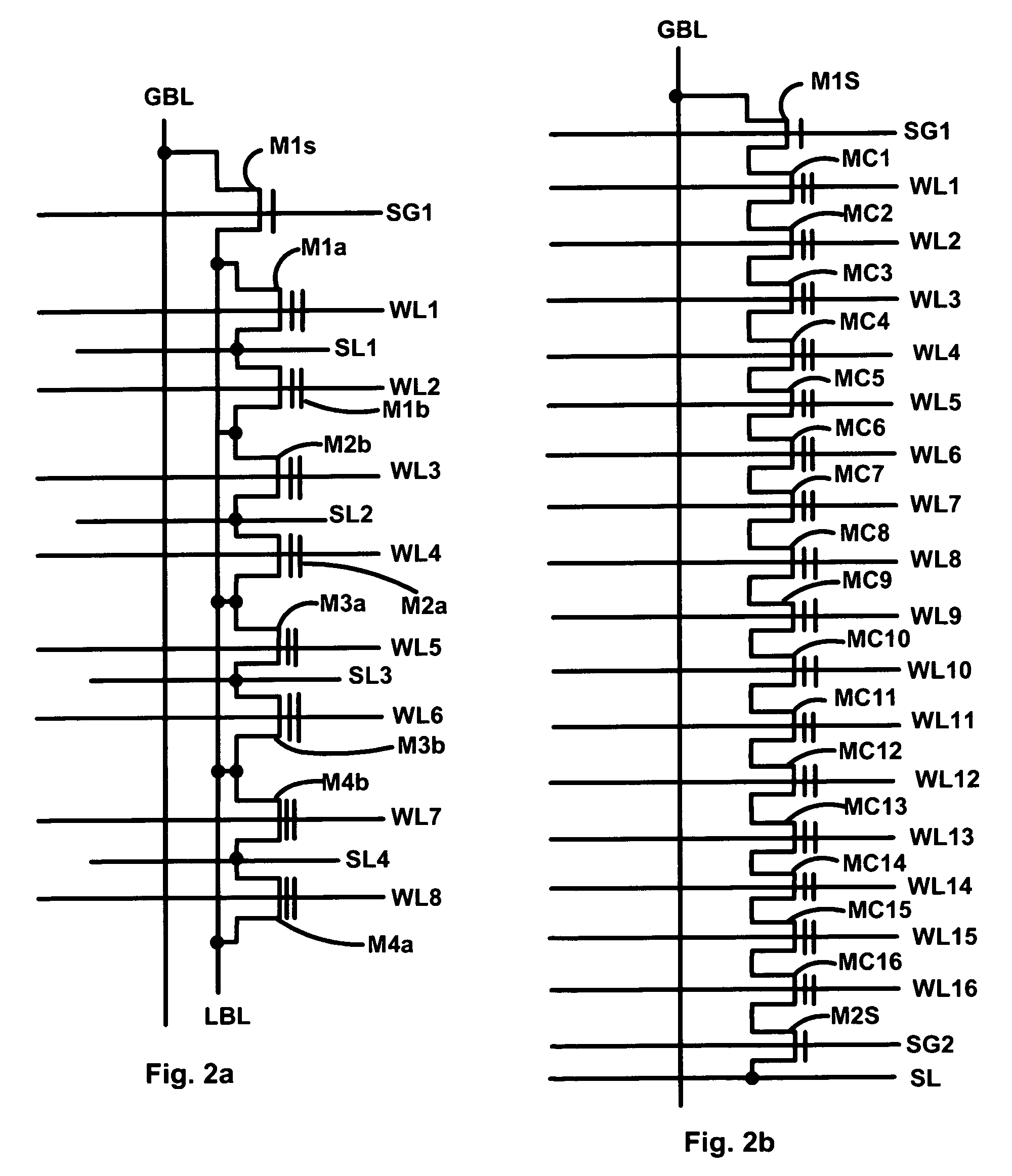[0031] If one of the plurality of nonvolatile memory arrays is the NAND configured flash memory, programming the selected first sub-arrays is accomplished by setting at least one bit line of the selected first sub-arrays to the second moderately high positive program voltage, at least one word line of the selected first sub-arrays to the very large positive programming voltage (+18V), at least one source line of the selected first sub-arrays to the second moderately high positive program voltage, and a bulk region of all cells of the selected first sub-array to the ground reference voltage. The first sub-arrays are programmed in approximately 200 μs.
[0032] Erasing selected second sub-arrays of the plurality of nonvolatile memory arrays configured as the NAND configured flash memory is accomplished by setting at least one word line of the selected second sub-arrays to the very large negative erasing voltage (−18V), very large negative erasing voltage (−18V), at least one source line of the selected second sub-arrays, and a bulk region of all cells of the selected second sub-array to the ground reference voltage. The second sub-arrays are erased in less than approximately 5 ms, preferably in less than approximately 2.5 ms.
[0033] If one of the plurality of nonvolatile memory arrays is the two transistor electrically erasable programmable read only memories, programming the selected first sub-arrays is accomplished by setting at least one bit line of the selected first sub-arrays to the intermediate positive program voltage, at least one select gate line of the selected sub-arrays to the power supply voltage, at least one word line of the selected first sub-arrays to the moderately high positive program voltage, at least one source line of the selected first sub-arrays to the ground reference voltage, and a bulk region of all cells of the selected first sub-array to the ground reference voltage. Those cells of the selected sub-array not programmed but have the word line at the moderately high positive program voltage are inhibited from programming by setting select gates of non-selected cells of the selected sub-arrays to the very large positive programming voltage (+18V). Those cells of non-selected sub-arrays not programmed are inhibited from programming by setting the bit lines, word lines, source lines, and the bulk region of all cells of the non-selected first sub-array of the non-selected cells to the ground reference voltage, select gates of non-selected cells of the selected sub-arrays to the power supply voltage. The first sub-arrays are programmed in less than approximately 5 ms, preferably less than approximately 2.5 ms.
[0034] Erasing selected second sub-arrays of one of the plurality of nonvolatile memory arrays configured as the two transistor electrically erasable programmable read only memories is accomplished by setting at least one select gate line of the selected sub-arrays to the power supply voltage, at least one word line of the selected second sub-arrays to the very large negative erasing voltage (−18V), at least one bit line of the selected second sub-arrays, at least one source line of the selected second sub-arrays, and a bulk region of all cells of the selected second sub-array to the ground reference voltage. The second sub-arrays are erased in less than approximately 5 ms, preferably in less than approximately 2.5 ms.
[0035] If one of the plurality of nonvolatile memory arrays is the three transistor electrically erasable programmable read only memories, programming the selected first sub-arrays is accomplished by setting at least one bit line of the selected first sub-arrays to the ground reference, at least one first select gate line of the selected sub-arrays to the power supply voltage, at least one word line of the selected first sub-arrays to the very large positive programming voltage (+18V), at least one source line of the selected first sub-arrays to the ground reference voltage, and a bulk region of all cells of the selected first sub-array to the ground reference voltage. Programming the selected first sub-arrays is further accomplished by setting at least one second select gate of the selected first sub-arrays to a ground reference voltage or to the power supply voltage. Those cells of the selected first sub-arrays not programmed but have the word line at the very large positive programming voltage (+18V) are inhibited from programming by setting bit lines of non-selected cells of the selected sub-arrays to the power supply voltage. The first sub-arrays are programmed in less than 10 μS, preferably less than approximately 1 μS.
[0036] Erasing the second selected sub-array of one of the plurality of nonvolatile memory arrays configured as the three transistor electrically erasable programmable read only memories is accomplished by setting at least one first select gate line and second select gate line of the selected sub-arrays to the power supply voltage, at least one word line of the selected second sub-arrays to the very large negative erasing voltage (−18V), at least one bit line of the selected second sub-arrays, at least one source line of the selected second sub-arrays, and a bulk region of all cells of the selected second sub-array to the ground reference voltage. The second sub-arrays are erased in less than approximately 5 ms, preferably, in less than approximately 2.5 ms.
 Login to View More
Login to View More  Login to View More
Login to View More 


